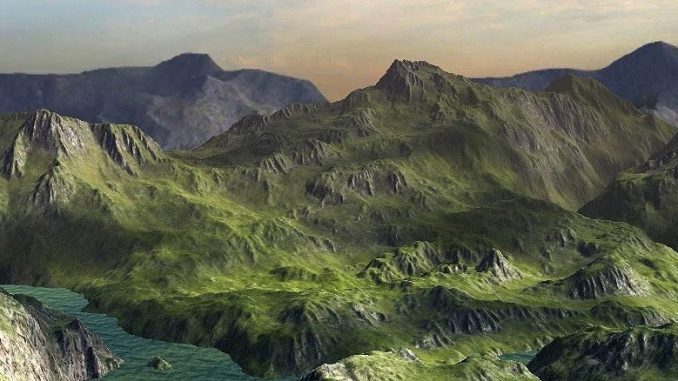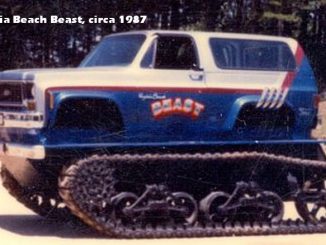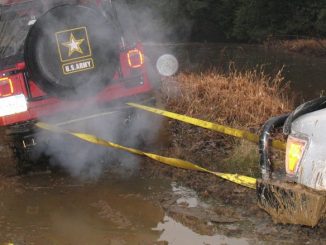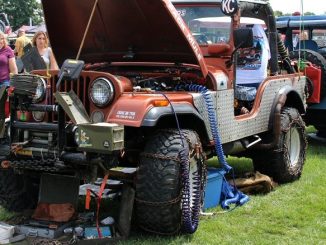
Most offroad driving is a matter of common sense and, often, seat of the pants intuition. The first rule is never to drive faster than is absolutely necessary, and to take obstacles at a slow and steady pace. This, with minor exceptions, will carry you through tough situations more easily than charging the obstacle. And charging obstacles will certainly damage your vehicle, perhaps terminally. In remote places, your life depends on your vehicle, so treat it with respect.
The second rule of offroading is always to prepare for the worst case scenario. If you have free-wheeling hubs, lock them as soon as you leave the road. I lock them when I leave the tarmac, so that if I hit a slippery or tricky patch, a flick of the transfer stick into high ratio four-wheel drive helps regain traction. The use of high range four-wheel drive on rough or corrugated tracks also halves the fatigue loading on the rear prop shaft and half shafts by evenly spreading the transmission loads and, depending on the vehicle, can significantly reduce fuel consumption.
Always select the gear you will need for a situation before entering it, and try to stick with that gear throughout: more vehicles bog down through botched gear changes than for any other reason. You must know the exact position of all the vulnerable undercarriage points (diffs, spring U-bolts, sump, steering rods) and steer accordingly.
Always walk a tricky section before driving it, so that you know exactly where the hidden obstacles are. Always keep both hands firmly on the steering-wheel and never hook your thumbs over the inside of the wheel as a sudden jolt could break your finger. Wear your seat-belt to prevent sliding around or cracking your head against the ceiling.
ROCKY TRACKS, GULLIES, RIDGES
Avoid the big rocks, drive slowly, and engage high ratio four-wheel drive to reduce transmission wear and give greater vehicle control. I drop my tire pressures to the point where the tire is just beginning to bulge, which makes the ride more comfortable, saves on suspension, and saves on punctures as the tire has some ‘give’ in it when it hits rocks, rather than presenting a rigid, hard surface which can split.
In deep V-shaped gullies, be careful not to drop one side of the vehicle into the deepest point: drive with the wheels straddling the gully so you don’t end up hopelessly jammed in a position where digging and pushing do not help. When approaching a small gully head-on, enter at an oblique angle, dropping and removing one wheel at a time into and from the gully.
BADLY RUTTED TRACKS
Heavily used tracks are often deeply rutted, to the point where it is impossible to drive without hooking up the undercarriage on the middelmannetjie. Drive with one wheel in a rut and the other on the hump to prevent your undercarriage getting hung up. If there is enough side room, drive with one wheel on the middle hump, and one on the far side of one of the ruts.
MUD
If you hit a bad hole you know you can’t get through, wait for the next big truck and negotiate a tow. This may cost a few bob, but it’s better than spending the night in the mud hole.
When driving through, first walk the route. Fill deep holes with rocks or other material. Check for alternative routes what looks like dense bush may be navigable. All water-filled holes must be waded through to establish their depth and any hidden hazards. Then map your route through the mud hole, using sticks jammed into the mud to indicate drop-offs and other hazards, and if there are two of you, one should navigate the driver through.
Mark the exact position your steering-wheel is in when the wheels are pointed dead ahead. It’s easy to turn your wheels too far to one side without realizing it, as the vehicle continues going in a straight line, getting more bogged by the second.
Select your driving gear, and try not to change gear throughout the crossing maintaining momentum is critical, but there is a very fine line between going too slowly and going dangerously fast. Low range second or third gear are your obvious choices, avoiding wheel spin. First gear gives too much torque and causes wheel spin.
Reduce power on slippery bits, and gently feed in power as soon as traction improves. If the wheels spin, gently drop the revs until they grip again. Jiggling the steering from side to side helps the wheels regain traction, but avoid exaggerated steering. If you start bogging down, stop immediately without braking. Get out and plot the best course of action before you bog to your axles usually this will mean simply reversing or a bit of minor digging.
SALT PAN MUD
Nasty stuff which regularly swallows entire vehicles on the salt pans of Botswana and the Sahara. This is the one type of mud where wide tires work. Deflate narrow tires to sand pressures. Under ordinary circumstances, never drive on salt pans this is environmentally destructive and potentially hazardous. But on remote expeditions, you may have no option but to cross them.
Never park on the pan while inspecting the surface a healthy pan can swallow a vehicle in minutes. Walk the pan. If the surface feels firm, dig a hole about half a metre deep: if you find dry ground all the way, then it may be safe to proceed. Drive slowly in low range third or fourth, and always stick close to the edges of the pan and near to, but not on, existing vehicle tracks. If you start to bog down, stop gently and reverse out.
RIVER CROSSINGS
Deep water river crossings are among the most dangerous of all offroad hazards. If you have any doubt about a river crossing, don’t do it. Find an alternative route, or wait for another vehicle to come along. And, when crossing a river, always prepare yourself for the worst possible scenario. (See Out There, November 1996.)
You must walk the route before driving it. If a river is flowing strongly enough to make you lose your footing, then it will be dangerous for your vehicle. If necessary, remove boulders. Mark obstacles with stakes, or have a passenger stand by them. Make sure that the exit point on the opposite bank is driveable. If the river is in flood because of a recent rain storm, set up camp and wait it out. In most parts of Africa, river levels drop very quickly after rain.
If the water is above the bottom of your door frames, open two opposite doors for the crossing so you don’t turn the vehicle into a floating box that flips over. If you have two vehicles, use one as a recovery vehicle.
Take the crossing at a slow and steady pace. Never change gear in the water: water will enter the clutch plate and cause the clutch to slip, leading to potentially disastrous loss of traction. Select your gear in advance low range second or first are probably your best options, depending on the severity of the crossing.
Proceed at a steady, fast walking pace this sets up a bow wave in front of the vehicle, pushing the water to the side. Once you are up and running, there is no stopping steady momentum is essential. If for any reason you should lose power and the bow wave overtakes you, switch off immediately before water gets sucked into the air intake or manifold, and into the cylinders. Isolate the batteries to prevent the starter motor shorting and turning the engine.
Don’t restart the engine unless you are certain no water has been sucked into the cylinders. If the water has risen higher than the inlet and exhaust valves or if your air intake is wet, then you have to assume water has entered the combustion chambers. If you can recover the vehicle without restarting the engine, then do so, rather than risk the possibility of damaging the engine.
ICE AND SNOW
Tires play a very important role in snow, and the deeper and chunkier your treads, the better. Decreasing tire pressure by a third improves traction. Wide tires are dangerous, as they float over the top. Wheel chains are a big help if you have them but they place an enormous strain on the drive train, and rip up the surface of tracks.
Take most tracks in high range second or third, avoid wheel spin, and always brake very gently, as front wheels lock with frightening speed on icy surfaces use gear changes or short, gentle taps on the brake to slow down.
SAND
Sand, particularly desert sand, is one big vehicle trap waiting to happen. You need to float over the top, not brute your way through. The only way to achieve this is by having a wide tire ‘footprint’ and keeping your momentum going. If your vehicle is fitted with standard issue ‘biscuit’ tires (the best all-round offroading wheels) deflate them so the side walls begin to bulge outward.
Most of the time, high range four-wheel drive will be fine, but when things get churned up, switch to low range. The hotter it is, the tougher the going, because as the sand heats up, moisture evaporates and the air molecules in the sand grains expand, making the surface looser and stickier. Heavy dew or light rain make a huge difference to traction, as does driving early in the morning or late afternoon.
Execute gear changes well before hitting the tricky patches, as sloppy gear changes cause wheel spin, which can bog you down, or worse, snap a halfshaft. Don’t fight the steering-wheel, rather grip it loosely and let the sand do the steering. Never use your brakes except in an extreme emergency, as braking will bog you down. Just take your foot off the accelerator, and allow the sand to bring you to a halt.
DESERT SAND DUNES
Sand dune driving is environmentally destructive and dangerous. But sometimes sand dune cresting is the only route through. Always carry out a walking check some gentle dunes hide steep drop-offs or rocky cliffs on the far side.
Drive onto the dunes head-on at right angles to the crest. Entering at an oblique angle can cause you to roll. Build up enough momentum to get you just to the top of the dune, at which point you need to halt the vehicle, with the nose pointing over the other side. Dig away the crest, dropping the nose, and descend slowly in low range second gear, and don’t touch the brake or accelerator pedals. Let the gears do the work as the brakes could lock and cause you to roll. Your descent must be dead straight if you head down at an angle, you will definitely take a tumble.
There are three conventional ways to approach bad corrugations: very fast, skimming over the top (a dangerous practice) very slow, so you drive up and over each rut and driving on the wrong side of the road, so you approach the corrugation from the ‘gentler’ side. I add a fourth, which is lowering tire pressures until they start to bulge. This works like an extra set of shock absorbers, and means you end the day in a far better mood than with hard tires. Punctures are cheap and easy to fix, a cracked chassis or smashed spring is not.
Watch out for changes in the colour of the sand on the road ahead this almost always signals a change in the consistency of the gravel.
OFFROAD DRIVING AND CONSERVATION
Offroad drivers have quite rightly been maligned and badmouthed in many parts of Africa because of cowboy driving which is environmentally destructive to highly sensitive ecosystems. It is the responsibility of all offroaders to behave in an environmentally sensitive way, or we could see former recreation areas being declared off-limits to us.
DESERTS
Driving off established tracks destroys ancient life-forms every metre of the way. Always stick to existing tracks. Every time you leave an established track, a new scar is created on the landscape, and the chances are good that someone travelling after you will follow your tracks thinking it is an established route. When forced to traverse a section of desert where there are no tracks, try to drive in dry river beds. Here, vehicle tracks will be washed away in the next flash flood.
BEACH DRIVING
Beach driving should be avoided unless you have no other option. Lower your tire pressures to avoid compacting sensitive areas (and to give better flotation) Try to stick as closely as possible to the wet sand area below the high tide mark where, because of wave action, the sand is tough and resilient. If this is not possible, drive as close to the high tide mark as possible.
Never ever drive on beach dunes. They are perhaps the most dynamic and vulnerable part of beach ecology; constantly changing building blocks which hold the beach together. The backshore section, mud flats and salt marshes are all environmentally fragile and must be avoided.
TRACK DAMAGE
One vehicle bogged on a bush track can destroy a road in just a few days as heavy rains gouge the initial hole into an erosion donga. When you bog down in dry or wet weather repair the hole afterwards. Divert any streams running through the danger area and mark the hole to warn other drivers. If you use firewood or branches to improve traction, remove them afterwards. They can cause terrible damage to the brake and fuel lines and electrical wiring of other vehicles.
BULL BARS AND WINCHING
Bull bars are there to protect your vehicle, not to bash your way through the bush for the fun of it. Doing so destroys vegetation. When winching off a tree, use a commercially available tree saver, a collar of thick rubber or a wadded up sack to protect the bark. Winch cables cut into the bark of a tree, ring barking it, and virtually guaranteeing it will die.




